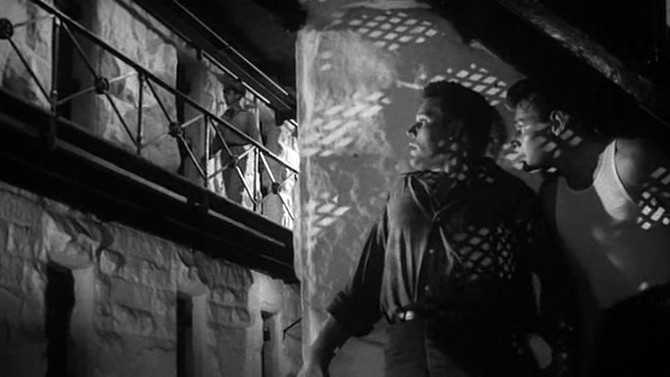With a stellar cast, those behind 1954’s Riot in Cell Block 11 did not take the approach of procuring the biggest names available, instead, they brought together a group of character actors that lived their parts – and all surrounded by real prisoners and guards, who played extras during production.
Directed by Don Siegel (Invasion of the Body Snatchers; Dirty Harry), and produced by Walter Wanger (inspired to make the film after serving a four month prison sentence and being wholly unnerved – he was jailed for shooting his wife’s [Joan Bennett] agent, Jennings Lang, whom she was having an affair with – one bullet penetrated his hip, the other, his groin – clearly we know what he was aiming at), the team cast Neville Brand as a convicted murderer who heads up the riot (the former World War 2 combat soldier was the fourth most decorated American from the period), while his ‘Crazy’ second in command was developed by Leo Gordon (another convict who was shot in the gut during an armed robbery).
Shot on location at the famed Folsom Prison, Warden Heinze was not overly fond of the project – not sure if he wanted to grant them permission to film there. As Wanger and Siegel brought the entire team in to meet him, the last to be introduced was one Sam Peckinpah (famed filmmaker of The Wild Bunch and Straw Dogs), a lowly third production assistant (basically a gopher for Siegel) and clever hire by Wanger. Basically ignoring every other person as they were introduced, Heinze’s head popped up when hearing the name, promptly asking if there was any relation to the famous Peckinpah family (influential judge and all) – acknowledging the connection, there were no longer any problems with the project.
Making a very different type of prison film (compared to all those other unrealistic Hollywood pieces), Siegel shot with a documentary style approach – starting with a newsreel type opening featuring real footage from actual riots (including a 1952 riot at State Prison in Jackson, Michigan – the motion picture is based on it). Almost feeling like it is being shot in real time, outside factors like the wives of the prisoners and guards are only discussed in relation to what is occurring on screen (and not seen until the utter end), all of the action taking place within the prison walls.
Living under horrible conditions, murderer James V. Dunn (Brand) and ‘Crazy’ Mike Carnie (Leo Gordon) catch the understaffed guards off-guard (for lack of a better term) one night, taking the four men hostage and demanding to meet with the Warden, Reynolds (Emile Meyer), with the press in tow.
Looking to improve their situation, they enlist the help of The Colonel (Robert Osterloh) – a former military man who is approaching a parole hearing. Not wanting to put his chance at freedom on the line, he grudgingly agrees to write their demands, while keeping at arm’s-length from the rest of the shenanigans.
With a Governor that is not willing to cave in to any demands, he sends his liaison, Commissioner Haskell (Frank Faylen) to aid with the escalating situation. The Warden is at his wit’s end, as he is stuck between a rock and a hard place – negative press does not negate the fact that the prisoners are demanding the very changes he has long been asking for. Will the rag tag team of cons and murderers be able to change the power of the well-oiled government machine, or will they fail in every which way?
Combining scathing social commentary with an effective narrative, the film draws us into their plight – making these would-be villains the protagonists of this tale. Yet, like in society beyond the walls as well, living together is not a simple thing, and factions start to crop up, dissension amongst the team. The two leaders are a perfect example. Dunn is a bright man, knowing that killing the guards will hinder the vital discussions, whilst the first thing on Crazy Mike’s mind is revenge against the sadistic men who beat and confine them. It is rather hard to negotiate when things are crumbling from the inside while they are being strangled, metaphorically speaking, by those just outside the walls.
Going against stereotypes (a Warden who sympathizes with his prisoners’ problems), Riot in Cell Block 11 is an original and thoughtful motion picture that was a huge hit at the box office. Featuring mesmerizing and realistic performances, an effective style of editing and direction, as well as a fascinating real life setting, it is part cynical film noir, part searing exploitative crime drama. So, don’t take thirty years to check this one out; make a change by entering Cell Block 11.


